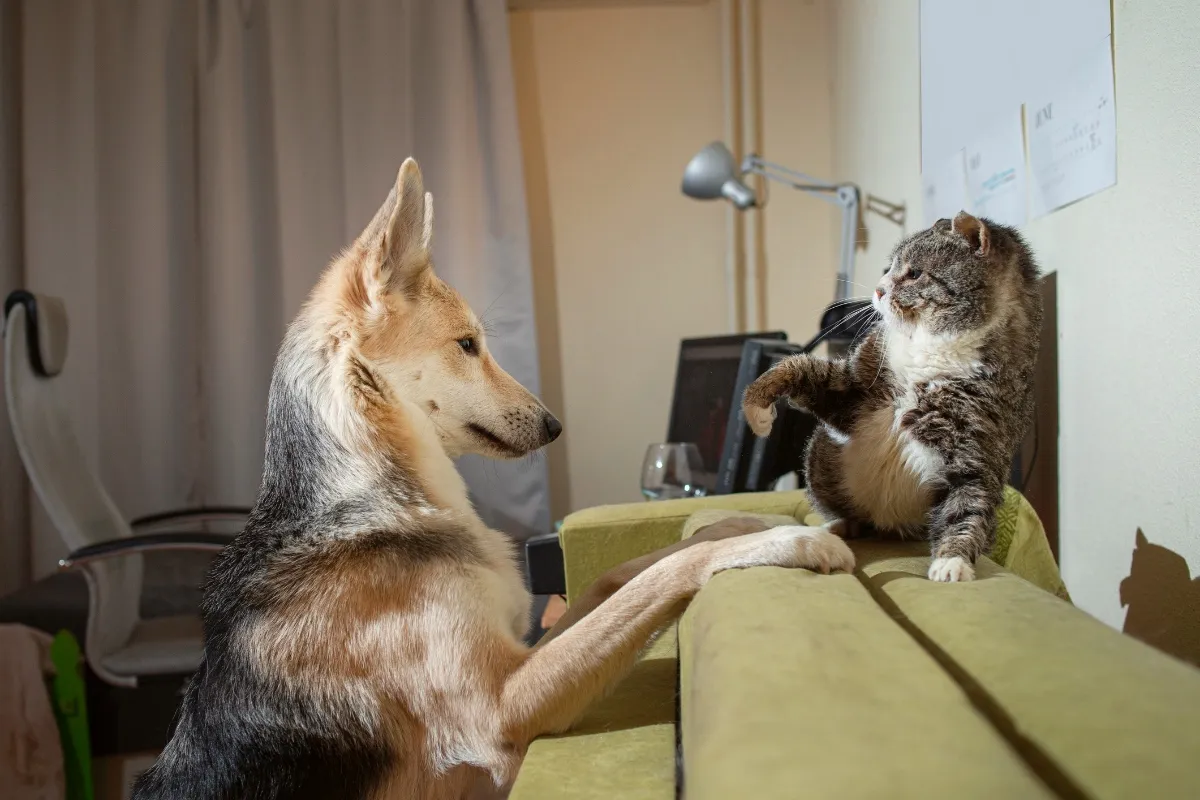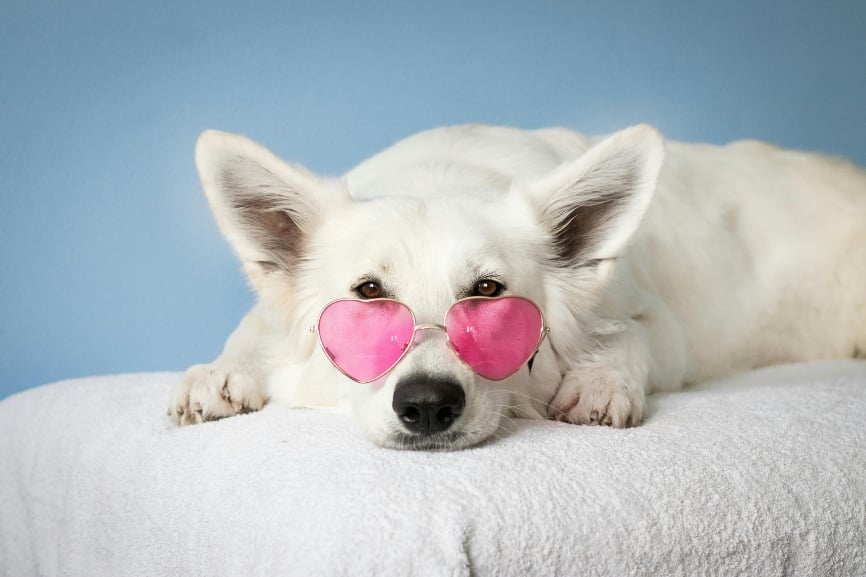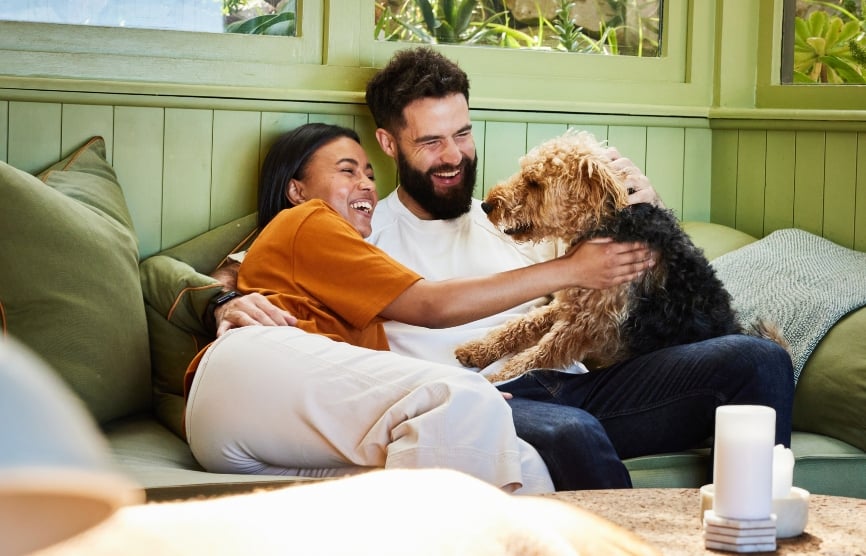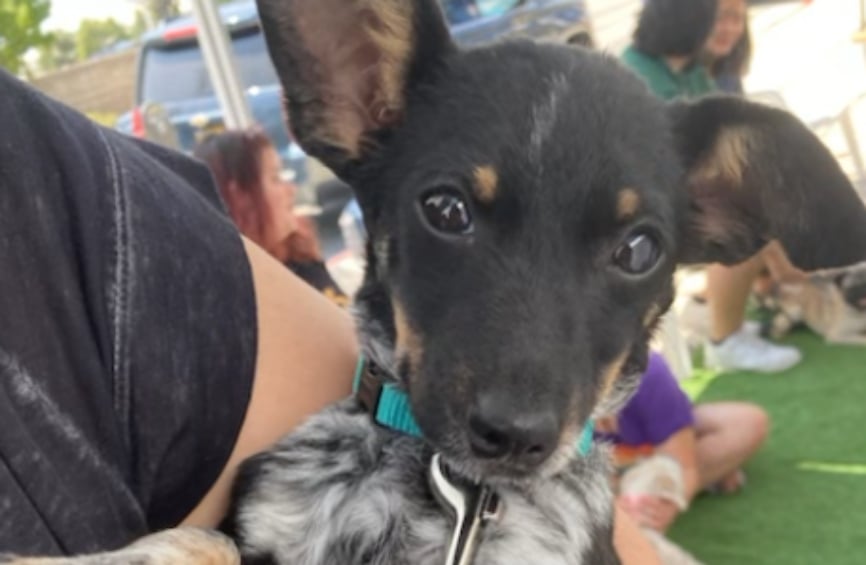Table of Contents
Despite common stereotypes, dogs and cats can get along well and coexist in the same household. Some dog breeds and personalities mesh better than others around cats, but with good training and early socialization, you can address common issues and live with both dogs and cats as pets in your home.
In this article, we address how to stop dog aggression towards cats so that you can be surrounded by all the furry friends you love. We’ll answer common pet issue questions, such as why do dogs chase cats, how to stop a dog from fixating on a cat, and what to do with dog-biting-cat scenarios, plus extra tips about living in harmony with your little zoo.
Issues Between Dogs and Cats
Cats and dogs are very different animal species with distinct behaviors, preferences, and needs. Common issues with these pets living together include dogs chasing cats, animals eating each other’s food, and dogs and cats that nip or bite each other. These issues can be troublesome or even dangerous if the pets do not respond to commands or follow house rules. Fortunately, obedience training can go a long way in preventing household stresses and ensuring that everyone feels safe and secure in a family living environment.
Most cats tend to keep to themselves around dogs, so the most common issues occur when dogs become aggressive toward cats. Aggression-related warning signs to look for include dogs that are overly focused on cats, cats that regularly hiss or swat at dogs, and dogs that lunge or snap at cats. Pet issues may also arise around feelings of jealousy, demands for attention, and eating troubles.
Why Do Dogs Chase Cats?
Many dogs chase cats because it is their instinct and part of how they were bred to hunt prey. Dogs have a long history of being bred and trained to herd and chase other animals, so it is not their fault for how humans adapted them long ago. The answer to “how to stop a dog from chasing a cat” involves understanding your dog’s personality, genetics, and upbringing.
Some dogs are naturally dominant, and some breeds have a naturally high prey drive. For example, prey drives tend to be exceptionally high in terriers, border collies, Australian shepherds, greyhounds, chihuahuas, and hounds. Dogs that were abused or neglected early in life may have lingering behavioral issues that require special attention. Some dogs are just very playful and mean no harm to cats but play a bit rougher than the average feline is used to. Meanwhile, some dogs are very territorial and exhibit aggressive and guarding behaviors that include lunging, snapping, and biting.
A dog’s reaction to cats may change with age, for the better or worse. Yet dogs need to understand that cats are companions to be respected, not toys to be handled roughly and potentially harmed. The good news is that hard work and persistence pay off with proper pet training and prompt attention to issues that arise.
How to Stop Dog from Chasing Cat
If you are adding a new pet to your household, it is a wise idea to match dog and cat personalities as much as possible. Dogs born with high prey drives will likely always have some of this in their systems. Meanwhile, some cats are more social and easygoing than others, which means that certain cats will be more receptive to dog companions than others. Older cats may get along better with older dogs, and the size of your pets can also be a consideration.
Once you have two or more pets of different species in your home, teaching your dog basic commands, such as sit, stay, come, and leave it, is crucial. Dogs need to learn how to control their behaviors in general before trying to control them around cats. It may be necessary to bring in a professional trainer for guidance if your dog is particularly stubborn or has a high prey drive.
How to Stop a Dog from Fixating on a Cat
If your dog won’t stop fixating on a cat, another strategy is to redirect the dog’s behavior by cat catching aggressive tendencies early. At the first sign of a dog lunging at a cat, you can tell your dog “no,” and put the dog in a room alone for a few minutes. Make sure to redirect the dog’s attention immediately because learned behaviors are challenging to unlearn. Reward your dog for listening to your commands and responding to your behavior redirection by giving treats or extra perks, such as more playtime outside or a long walk after your commands are respected.
Initially, you may need to keep your dog on a leash inside your home for your cat’s safety. Once you start feeling more comfortable with your dog and cat in the same space, you can give your cat some escape routes by placing a cat condo, climbable cat trees, or pieces of tall furniture that the kitty can access but that the dog can’t reach.
For dogs having trouble adjusting to a new cat in the house, focus more attention on exercising your dog to burn off excess energy so that the pup has less built-up energy to chase cats. You can also exercise your cat and keep your cat mentally stimulated with interactive toys, playtime, and clicker training. Well-exercised and entertained pets are generally happier and less likely to act aggressively.
Addressing Dog Biting Cat Issues
If you experience a dog-biting-cat issue, you must address it immediately for everyone’s safety. Biting can be an advanced form of aggression and put your cat at serious risk. But subtle nibbling on a cat’s neck may indicate that your dog is simply being playful. A dog biting a cat may be a friendly grooming behavior, a gesture of affection, or a direct way to get the cat’s attention. Very minor nibbling is usually not a major cause for concern as long as the cat is okay with it.
But if you notice bite marks or other injuries on your cat, observe their play styles carefully. Biting can be a sign of jealousy or to show dominance. Dogs must be trained to tolerate and be gentle with cats if this is your situation. Biting can be a sign of stress in dogs, so if your dog is stressed, you may need to find ways to alleviate that stress with more exercise, a special anxiety vest, or other calming activities before interacting with a cat. If biting is accompanied by growling, snarling, or body tension, it can be interpreted as aggressive and cause problems in a household.
If your dog injures your cat, address the bleeding with direct pressure to the wound, examine the cat for other wounds, and clean the wound with an antiseptic solution. Dog bites can cause serious complications if left untreated, so you must be mindful of potential abscesses and the dog’s vaccination status. Make an appointment with your vet as soon as possible, even if the cat’s wounds seem minor. Your vet can discuss treatment options with you based on the severity of the wounds. Then you’ll need to handle after-care procedures back at home for your cat, such as preventing wound-licking, changing bandages, and preventing similar accidents in the future.
When to a Consult a Professional Behaviorist
Dogs and cats are often not instant friends and need a few introductions to get used to each other. This process may involve keeping them in separate rooms until they get used to each other’s smells and sounds through the door. You can keep their feeding stations separate so that food stealing is not an issue and place a baby gate between them so that they can get acquainted in a safe and controlled way. Some dogs and cats will learn to live together without human supervision, while others may always need to be supervised and separated when no one is home to monitor their safety.
However, pet training is a valuable skill that not everyone can do or has time for. If you have tried to teach your dog obedience skills without success or can’t commit to a regular dog training schedule, it may be time to enlist the help of a professional. You can sign your dog up for group classes with other dogs and pet parents or contact a trainer for one-on-one support to address a specific behavioral issue. Qualified animal behaviorists are equipped with the experience, knowledge, and patience necessary to deal with complex issues ranging from aggression to separation anxiety, compulsive behaviors, phobias, and past trauma. Animal behavior consultants differ from standard trainers because they are equipped to handle more significant issues beyond just learning basic obedience skills.
When hiring a dog behaviorist, consider candidates who have worked with dogs similar to yours and who focus on positive reinforcement methods. Since behaviorists work in a more specialized role than trainers, you may need to get on a waiting list or travel to find one that meets your needs and has the proper skill set to work with your dog.
Taking the Best Care of Dogs and Cats
Living peacefully and confidently in a household with both dogs and cats can be a wonderful experience and rewarding to all four-legged and two-legged members of your family. As you get ready to introduce dogs and cats for the first time, it is a good idea to be proactive about their health and be as prepared as possible for whatever may happen.
Healthy Paws offers pet insurance for dogs and cats so that you can take care of all your pets’ health insurance needs in one place. Our dog insurance plan covers pooches ranging in age from puppies just eight weeks old to seniors up to 14 years of age so they can be cared for if scratched, bitten, or otherwise injured by a cat. Our cat insurance plan is available for kittens to senior cats and can help you pay costly vet bills if your kitty is hurt by a dog playing too roughly or biting aggressively. Beyond accidental injuries and emergencies caused by dog and cat encounters, our insurance plans help pet parents pay for treatments related to genetic conditions, breed-specific conditions, cancer, and alternative care.
If you live with dogs and cats, you need Healthy Paws by your side. We’ll help you find peace of mind so that you don’t have to worry about paying for vet bills if your dog or cat becomes injured or falls ill unexpectedly.
We wish you the best of luck in helping your dogs and cats to get along and play nicely with each other, and we have confidence that you can find a situation that works for your household! For more tips about pet care, training, and stories, check out the Healthy Paws Pet Care Blog to learn something new and help your pets live their very best lives.






